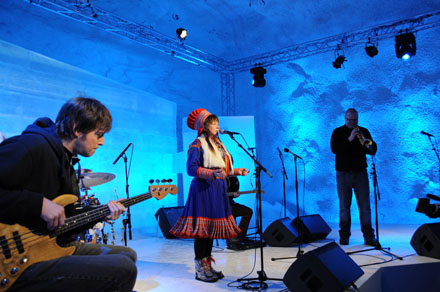Navigation
Svalbard Global Seed Vault in the Arctic Opens Doors for 100 Million Seeds from 100 Countries
The Svalbard Global Seed Vault established in the permafrost in the mountains of Svalbard opened on February 26, 2008 on a remote island in the Arctic Circle, receiving inaugural shipments of 100 million seeds that originated in over 100 countries.
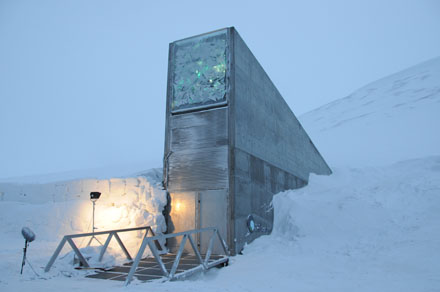 |
| Built near the village of Longyearbyen on the island of Spitsbergen, the vault at its inception contains 268,000 distinct samples of seeds - each one originating from a different farm or field in the world. Each sample may contain hundreds of seeds or more. In all, the shipments of seeds secured in the vault today weighed an approximately astonishing 10 tons, filling 676 boxes. Photo: Mari Tefre |
The Svalbard Global Seed Vault established in the permafrost in the mountains of Svalbard opened on February 26, 2008 on a remote island in the Arctic Circle, receiving inaugural shipments of 100 million seeds that originated in over 100 countries.
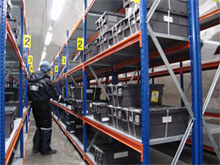 |
| Seed boxes stored inside vault. Photo by Mari Tefre |
Some 268,000 seed samples that represent the agriculture of 220 countries have already been catalogued, coded and moved into the Vault. The Vault, designed to store duplicates of seeds from seed collections, sent seeds from 20 different research institutes and national gene collections.
The importance of preserving seeds is stated in the International Treaty for Plant Genetic Resources for Food and Agriculture (ITPGRFA) description of its purpose: “Plant genetic resources for food and agriculture are crucial in feeding the world's population. They are the raw material that farmers and plant breeders use to improve the quality and productivity of our crops. The future of agriculture depends on international cooperation and on the open exchange of the crops and their genes that farmers all over the world have developed and exchanged over 10,000 years. No country is sufficient in itself. All depend on crops and the genetic diversity within these crops from other countries and regions.”
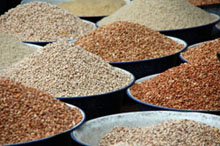 |
| Cowpea seeds Photo credit: ITTA |
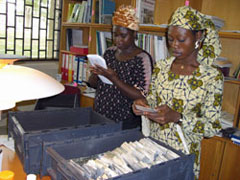 |
| Genebank staff checking accession number as they are packed in shipment box at the International Institute of Tropical Agriculture in Nigeria (IITA). |
With the deposits ranging from unique varieties of major African and Asian food staples such as maize, rice, wheat, cowpea, and sorghum to European and South American varieties of eggplant, lettuce, barley, and potato, the first deposits into the seed vault represent the most comprehensive and diverse collection of food crop seeds being held anywhere in the world.
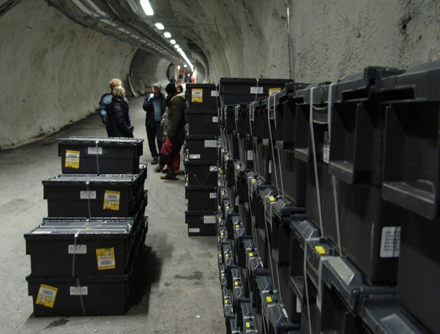 |
| Built near the village of Longyearbyen on the island of Spitsbergen, the vault at its inception contains 268,000 distinct samples of seeds - each one originating from a different farm or field in the world. Each sample may contain hundreds of seeds or more. In all, the shipments of seeds secured in the vault today weighed an approximately astonishing 10 tons, filling 676 boxes. |
This represents just a small fraction of the eventual capacity of the vault that could easily hold more than 2 billion seeds. Now that the Seed Vault has opened, its main work will be receiving, recording and storing the seeds that are being sent to Svalbard for safe keeping by gene banks around the world. Many of these collections are from developing countries. If seeds are lost, e.g. as a result of natural disasters, war or simply a lack of resources, the seed collections may be reestablished using seeds from Svalbard.
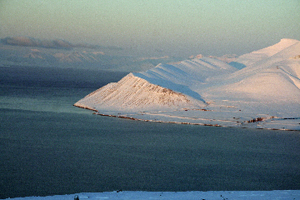 |
| Longyearbyen Photo by Stein Arne Nistad, Gazette |
Although the normal temperature inside the permafrost mountain is between minus 1 - 2 degrees Celsius, the optimum goal for the storage of the seeds is minus 20 degrees Celsius (about minus 4 degrees Fahrenheit). Huge coolers have been running in the vault since November 2007. The low temperature and moisture level inside the vaults will ensure low metabolic activity, keeping the seeds viable.
The Svalbard Global Seed Vault will be the ultimate safety net for the world’s most important natural resource. If properly stored and maintained some seeds in the vault will be viable for a millennium or more. For example, barley can last 2000 years, wheat 1700 years, and sorghum almost 20,000 years.
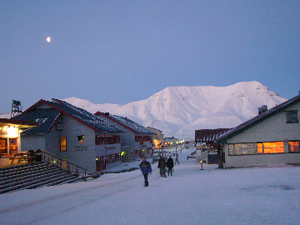 |
| Longyearbyen Photo by Heidi Eriksen, Ministry of Agriculture and Food |
Built near the village of Longyearbyen on the island of Spitsbergen, the vault at its inception contains 268,000 distinct samples of seeds - each one originating from a different farm or field in the world. Each sample may contain hundreds of seeds or more. In all, the shipments of seeds secured in the vault today weighed an approximately astonishing 10 tons, filling 676 boxes.
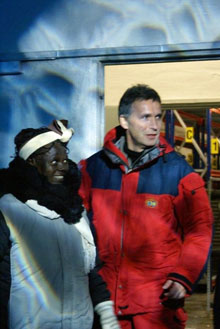 |
| Nobel laureate Mathai and Prime Minister Stoltenberg delivered the first seed box in the Svalbard Global Seed Vault, Longyearbyen, Svalbard Photo by: Simon Jeppson |
The opening of the seed vault is part of an unprecedented effort to protect the planet’s rapidly diminishing biodiversity. The diversity of our crops is essential for food production, yet it is being lost. This “fail-safe” facility, dug deep into the frozen rock of an Arctic mountain, will secure for centuries, or longer, hundreds of millions of seeds representing every important crop variety available in the world today.
As well as protecting against the daily loss of diversity, the vault could also prove indispensable for restarting agricultural production at the regional or global level in the wake of a natural or man-made disaster.
Contingencies for climate change have been worked into the plan. Even in the worst-case scenarios of global warming, the vault rooms will remain naturally frozen for up to 200 years.
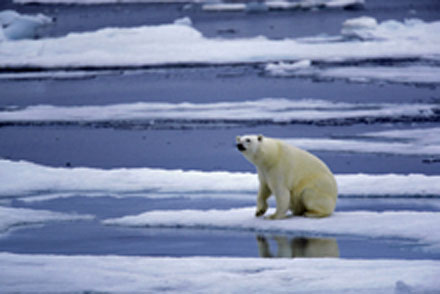 |
| Polar bear Ursus maritimus in summer. Spitzbergen, Svalbard, Norway |
“With climate change and other forces threatening the diversity of life that sustains our planet, Norway is proud to be playing a central role in creating a facility capable of protecting what are not just seeds, but the fundamental building blocks of human civilization,” said Norway’s Prime Minister Jens Stoltenberg.
The Svalbard Global Seed Vault is funded and established by Norway as a service to the world. The Global Crop Diversity Trust is providing support for the ongoing operations of the seed vault, as well as organizing and funding the preparation and shipment of seeds from developing countries to the facility. The NordGen will manage the facility and maintain a public on-line database of samples stored in the seed vault, which has the capacity to house 4.5 million samples-some 2 billion seeds.
The Seed Vault is designed to store duplicates of seeds from seed collections from around the globe. If seeds are lost, e.g. as a result of natural disasters, war or simply a lack of resources, the seed collections may be reestablished using seeds from Svalbard. The seed vault is owned by the Norwegian government which has also financed the construction work, costing nearly NOK 50 million.
“Crop diversity will soon prove to be our most potent and indispensable resource for addressing climate change, water and energy supply constraints, and for meeting the food needs of a growing population,” said Cary Fowler, Executive Director of the Global Crop Diversity Trust. “The rooms are taking longer to cool to the optimal minus 18 than expected, but that is actually good news for the long-term operation of the Vault. The slow cooling indicates that the mountain rock that surrounds the vault is more impervious to temperature changes than had been believed and, thus, will also be more resistant to increases in air temperature in the case of global warming.”
The Prime Minister Stoltenberg and Wangari Maathai, founder of the African Green Belt Movement and 2004 Nobel Peace Prize Laureate, delivered together the first box of seeds to the vault. It contained rice seeds specially prepared with varieties originating from 104 countries. The box was opened during the ceremony, and then resealed before being placed in the vault.
“The significant public interest in the seed vault projects indicates that collectively we are changing the way we think about environmental conservation. We now understand that along with international movements to save endangered species and the rainforests of the world, it is just as important for us to conserve the diversity of the world’s crops for future generations,” Maathai said.
“The opening of the seed vault marks a historic turning point in safeguarding the world’s crop diversity,’’ said Fowler. “But about 50 percent of the unique diversity stored in seed banks still is endangered. We are in the midst of trying to rescue these varieties. Our success means we will guarantee the conservation and availability of these wildly diverse crops. Forever.”
The Facility
Svalbard Global Seed Vault lies about 1 kilometre from Longyearbyen Airport as the crow flies, at about 130 metres above sea level and consists entirely of an underground facility, blasted out of the permafrost (at about minus 3-4 degrees Celsius). The facility is designed to have an almost “endless” lifetime.
The location takes into account all known scenarios for rising sea level caused by global climate changes. The facility has also been located so deep inside the mountain that any possible changes to Svalbard’s climate, which we know about today, will not affect the efficacy of the permafrost. This will be a temporary temperature back up in the event of technical failure, such as loss of power supplies for a period.
Three underground chambers
 |
| Drawing: Global Crop Diversity Trust |
 |
| The vault consists of three highly secure rooms sitting at the end of a 125-metre tunnel blasted out of a mountain on Norway’s Svalbard archipelago. The seeds will be stored at minus 18 degrees Celsius (minus 0.4 degrees Fahrenheit) and sealed in specially-designed four-ply foil packages. The packages are sealed inside boxes and stored on shelves inside the vault. Each vault is surrounded by frozen arctic permafrost, ensuring the continued viability of the seeds should the electricity supply fail. Drawing credit: Global Crop Diversity Trust |
The facility consists of three separate underground chambers. Each chamber has the capacity to store 1,5 million different seed samples. With the aid of its own electric machinery, powered by electricity from the local power station, it will maintain a constant interior temperature of minus 18 degrees Celsius. The chambers will have storage shelving for prepacked examples of food seeds from the depositors (donor countries).
The storage chambers themselves are reached via an access tunnel about 100 metres long, with an entrance portal on its outside. The entrance portal will be the only visible part of the facility. It is in the form of a long, narrow concrete “fin”, with an entrance of brushed steel. An artistic decoration on the outer roof surface and on the upper part of the front will partly reflect the polar light and partly give off a muted, glowing light.
Anyone seeking access to the seeds themselves will have to pass through four locked doors: the heavy steel entrance doors, a second door approximately 115 metres down the tunnel and finally the two keyed air-locked doors. Keys are coded to allow access to different levels of the facility. Not all keys will unlock all doors. Motion detectors are set up around the site. Boxes of seeds inside the rooms are scanned before entering the seed vault.
Notes:
Svalbard Global Seed Vault on the web:
The three partners in the project all have web sites with background information about the Seed Vault. The official website of the project is the one managed by the Ministry in Norway.
At the Royal Norwegian Ministry of Agriculture and Food
At the Global Crop Diversity Trust
At the Nordic Genetic Resource Center (NORDGEN)
Welcome to the Svalbard Global Seed Vault (SGSV) Seed Portal
The Svalbard Global Seed Vault is now open.
This data portal serves two main users:
For depositors: The seed portal provides a way to submit inventories of the material they wish to deposit in the Seed Vault - see the Depositor Guidelines tab in the menu above.
For the general public: The seed portal is a way to find basic information about the seed samples conserved in the Seed Vault - see the Information Sharing tab in the menu above.
SGSV Seed Portal
The data in the Svalbard Global Seed Vault (SGSV) Seed Portal will build on, and be fully compatible with, the new global accession level data portal for access to PGRFA data under development by Bioversity International with contribution from NORDGEN, and supported by the Global Crop Diversity Trust.
|
Search
Latest articles
Agriculture
- World Water Week: Healthy ecosystems essential to human health: from coronavirus to malnutrition Online session Wednesday 24 August 17:00-18:20
- World Water Week: Healthy ecosystems essential to human health: from coronavirus to malnutrition Online session Wednesday 24 August 17:00-18:20
Air Pollution
- "Water and Sanitation-Related Diseases and the Changing Environment: Challenges, Interventions, and Preventive Measures" Volume 2 Is Now Available
- Global Innovation Exchange Co-Created by Horizon International, USAID, Bill and Melinda Gates Foundation and Others
Biodiversity
- It is time for international mobilization against climate change
- World Water Week: Healthy ecosystems essential to human health: from coronavirus to malnutrition Online session Wednesday 24 August 17:00-18:20
Desertification
- World Water Week: Healthy ecosystems essential to human health: from coronavirus to malnutrition Online session Wednesday 24 August 17:00-18:20
- UN Food Systems Summit Receives Over 1,200 Ideas to Help Meet Sustainable Development Goals
Endangered Species
- Mangrove Action Project Collaborates to Restore and Preserve Mangrove Ecosystems
- Coral Research in Palau offers a “Glimmer of Hope”
Energy
- Global Innovation Exchange Co-Created by Horizon International, USAID, Bill and Melinda Gates Foundation and Others
- Wildlife Preservation in Southeast Nova Scotia
Exhibits
- Global Innovation Exchange Co-Created by Horizon International, USAID, Bill and Melinda Gates Foundation and Others
- Coral Reefs
Forests
- NASA Satellites Reveal Major Shifts in Global Freshwater Updated June 2020
- Global Innovation Exchange Co-Created by Horizon International, USAID, Bill and Melinda Gates Foundation and Others
Global Climate Change
- It is time for international mobilization against climate change
- It is time for international mobilization against climate change
Global Health
- World Water Week: Healthy ecosystems essential to human health: from coronavirus to malnutrition Online session Wednesday 24 August 17:00-18:20
- More than 400 schoolgirls, family and teachers rescued from Afghanistan by small coalition
Industry
- "Water and Sanitation-Related Diseases and the Changing Environment: Challenges, Interventions, and Preventive Measures" Volume 2 Is Now Available
- Global Innovation Exchange Co-Created by Horizon International, USAID, Bill and Melinda Gates Foundation and Others
Natural Disaster Relief
- STOP ATTACKS ON HEALTH CARE IN UKRAINE
- Global Innovation Exchange Co-Created by Horizon International, USAID, Bill and Melinda Gates Foundation and Others
News and Special Reports
- World Water Week: Healthy ecosystems essential to human health: from coronavirus to malnutrition Online session Wednesday 24 August 17:00-18:20
- STOP ATTACKS ON HEALTH CARE IN UKRAINE
Oceans, Coral Reefs
- World Water Week: Healthy ecosystems essential to human health: from coronavirus to malnutrition Online session Wednesday 24 August 17:00-18:20
- Mangrove Action Project Collaborates to Restore and Preserve Mangrove Ecosystems
Pollution
- Zakaria Ouedraogo of Burkina Faso Produces Film “Nzoue Fiyen: Water Not Drinkable”
- "Water and Sanitation-Related Diseases and the Changing Environment: Challenges, Interventions, and Preventive Measures" Volume 2 Is Now Available
Population
- "Water and Sanitation-Related Diseases and the Changing Environment: Challenges, Interventions, and Preventive Measures" Volume 2 Is Now Available
- "Water and Sanitation-Related Diseases and the Changing Environment: Challenges, Interventions, and Preventive Measures" Volume 2 Is Now Available
Public Health
- Honouring the visionary behind India’s sanitation revolution
- Honouring the visionary behind India’s sanitation revolution
Rivers
- World Water Week: Healthy ecosystems essential to human health: from coronavirus to malnutrition Online session Wednesday 24 August 17:00-18:20
- Mangrove Action Project Collaborates to Restore and Preserve Mangrove Ecosystems
Sanitation
- Honouring the visionary behind India’s sanitation revolution
- Honouring the visionary behind India’s sanitation revolution
Toxic Chemicals
- "Water and Sanitation-Related Diseases and the Changing Environment: Challenges, Interventions, and Preventive Measures" Volume 2 Is Now Available
- Actions to Prevent Polluted Drinking Water in the United States
Transportation
- "Water and Sanitation-Related Diseases and the Changing Environment: Challenges, Interventions, and Preventive Measures" Volume 2 Is Now Available
- Urbanization Provides Opportunities for Transition to a Green Economy, Says New Report
Waste Management
- Honouring the visionary behind India’s sanitation revolution
- Honouring the visionary behind India’s sanitation revolution
Water
- Honouring the visionary behind India’s sanitation revolution
- Honouring the visionary behind India’s sanitation revolution
Water and Sanitation
- Honouring the visionary behind India’s sanitation revolution
- Honouring the visionary behind India’s sanitation revolution

